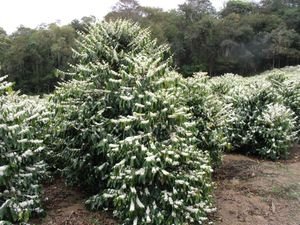Coffee bean types

There are two main species of the coffee plant, Coffea arabica being the older one. It is thought to be indigenous to Ethiopia, arabica was first cultivated on the Arabian Peninsula. While it is more susceptible to disease, it is considered by most to taste better than the second species, Coffea canephora (robusta). Robusta, which contains about 40-50% more caffeine, can be cultivated in environments where arabica will not thrive. This has led to its use as an inexpensive substitute for arabica in many commercial coffee blends. Compared to arabica, robusta tends to be bitter and has little flavor, with a telltale "burnt rubber" or "wet cardboard" aroma and flavor. Good quality robustas are used as ingredients in some espresso blends to provide a better "crema" (foamy head), and to lower the ingredient cost. In Italy many espresso blends are based on dark-roasted robusta. The large industrial roasters use a steam treatment process to remove undesirable flavors from robusta beans for use in mass-marketed coffee blends.
The largest coffee exporting nation remains Brazil, but in recent years the green coffee market has been flooded by large quantities of robusta beans from Vietnam. Many experts believe this giant influx of cheap green coffee after the collapse of the International Coffee Agreement of 1975-1989 with Cold War pressures led to the prolonged pricing crisis from 2001 to 2004. In 1997 the "c" price of coffee in New York broke US$3.00/lb, but by late 2001 it had fallen to US$0.43/lb. Robusta coffees (traded in London at much lower prices than New York's Arabica) are preferred by large industrial clients (multinational roasters, instant coffee producers, etc.) because of their lower cost.
The preference of the "Big Four" coffee companies for cheap robusta is believed by many to have been a major contributing factor to the crash in coffee prices and the demand for high-quality arabica beans is only slowly recovering. After the crash, many coffee farmers in Africa, Indonesia and South and Central America lost their livelihoods, or turned to illicit crops such as coca to earn a living. The Fair Trade organization has attempted to remedy the situation by guaranteeing coffee growers a negotiated pre-harvest price; many smaller roasters and recently Proctor & Gamble and Starbucks have joined Fair Trade. Another issue with coffee is ecological: the American Birding Association has led a campaign for sustainably harvested, shade-grown and organic coffees vs. the newer mono-cropped full-sun varieties, which lead to deforestation and loss of bird habitat
Arabica coffees were traditionally named by the port they were exported from, the two oldest being Mocha, from Yemen, and Java, from Indonesia. The modern coffee trade is much more specific about origin, labeling coffees by country, region, and sometimes even the producing estate. Varietal is a botanical term denoting a taxonomic category ranking below species, a designation more specific than arabica or robusta and unrelated to the coffee's place of origin. Coffees consisting entirely of beans from a single varietal, bourbon, for example, are generally referred to as such, along with a reference to their place of origin (as in: Rwanda Blue Bourbon). Coffee aficionados may even distinguish auctioned coffees by lot number.
Most arabica coffee beans originate from one of three growing regions; Central America, East Africa/Arabia, and Asia/Pacific. Beans from different countries or regions usually have distinctive characteristics such as flavor (flavor criteria include terms such as "citrus-like" or "earthy"), aroma (sometimes "berry-like" or "flowery"), body or mouthfeel, and acidity. Acidity refers to a tangy or clean-tasting quality, typically present in washed or wet processed coffees. It does not refer to a coffee's pH level. (black coffee has a pH of around 5). These distinguishing taste characteristics are dependent not only on the coffee's growing region, but also on its method of process and genetic subspecies or varietal.
"Caracoli," also known as peaberry, is a coffee bean which develops singly inside the coffee cherry, which normally contains two. The Caracoli beans occur in all regions of the world, on all types of coffee bush (~4% of all beans). Since flavour is concentrated when only a single bean is grown inside the cherry, Caracoli beans (especially Arabica) are highly prized.

0 Comments:
Post a Comment
<< Home